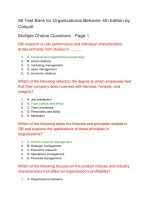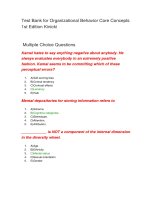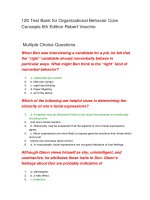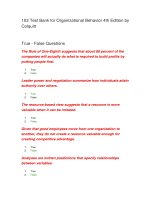Organizational behavior core concepts by kinicki chapter8
Bạn đang xem bản rút gọn của tài liệu. Xem và tải ngay bản đầy đủ của tài liệu tại đây (379.31 KB, 35 trang )
8
Organizational Behavior
core concepts
Conflict and Negotiation:
Why Conflict Arises and
What to Do About It
8-2
McGraw-Hill/Irwin
Organizational Behavior, Core Concepts
Copyright © 2008 by the McGraw-Hill Companies, Inc. All rights reserved.
Learning Objectives
• Distinguish between functional and
dysfunctional conflict, and identify desirable
outcomes of conflict
• Define personality conflicts, and explain how
they should be managed
• Discuss ways to manage intergroup conflict,
including in-group thinking and cross-cultural
conflict
8-3
Learning Objectives
• Describe methods for promoting functional
conflict and styles of handling conflict
• Identify and describe techniques for alternative
dispute resolution
• Summarize basic approaches to negotiation,
giving applications
8-4
A Modern View of Conflict
• Conflict
– one party perceives
its interests are being
opposed or set back
by another party
8-5
Functional versus Dysfunctional
Conflict
• Functional conflict
– serves organization’s interests.
• Dysfunctional conflict
– threatens organization’s interests.
8-6
Antecedents of Conflict
•
•
•
•
•
•
•
8-7
Incompatible personalities or value systems.
Overlapping or unclear job boundaries.
Competition for limited resources.
Interdepartment/intergroup competition.
Inadequate communication.
Interdependent tasks.
Organizational complexity
Antecedents of Conflict
• Unreasonable or unclear policies, standards, or
rules.
• Unreasonable deadlines or extreme time
pressure.
• Collective decision making
• Decision making by consensus.
• Unmet expectations.
• Unresolved or suppressed conflict.
8-8
Why People Avoid Conflict
•
•
•
•
•
•
8-9
Harm
Rejection
Loss of relationship
Anger
Being seen as selfish
Saying the wrong
thing
• Failing
• Hurting someone
else
• Getting what you
want
• Intimacy
The Conflict Iceberg
8-10
Desired Outcomes of Conflict
1. Agreement
2. Stronger
relationships
3. Learning
8-11
Major Forms of Conflict
• Personality conflict
• Intergroup conflict
• Cross-cultural conflict
8-12
Major Forms of Conflict
• Personality conflict
– interpersonal opposition driven by personal
dislike or disagreement.
8-13
How to Deal With Personality Conflicts
8-14
Intergroup Conflict
• Intergroup conflict
– conflict among work groups, teams, and
departments
• Too much cohesiveness can breed groupthink
because a desire to get along pushes aside
critical thinking
8-15
Handling Intergroup Conflict
• Contact hypothesis
– the more the members of different groups
interact, the less intergroup conflict they will
experience
• Managers should identify and root out specific
negative linkages between groups
8-16
Handling Intergroup Conflict
Group members are likelier to perceive
intergroup heroes when:
1. Conflict within the group is high
2. Negative interactions occur between groups
or members of groups
3. Influential third parties engage in negative
gossip about the other group
8-17
How to Build
Cross-Cultural Relationships
•
•
•
•
•
•
•
•
•
8-18
Be a good listener
Be sensitive to the needs of other
Be cooperative, rather than overly competitive
Advocate inclusive (participative) leadership
Compromise rather than dominate
Build rapport through conversations
Be compassionate and understanding
Avoid conflict by emphasizing harmony
Nurture others (develop and mentor)
Programming Functional Conflict
• Programmed Conflict
– encourages different opinions without
protecting management’s
personal feelings.
8-19
Programming Functional Conflict
• Devil’s advocacy
– assigning someone the role of critic.
• Dialectic method
– fostering a debate of opposing viewpoints to
better understand an issue.
8-20
Five Conflict Handling Styles
8-21
Figure 8-3
Question?
Which style for handling conflict relies on formal
authority to force compliance?
A. Integrating
B. Obliging
C. Dominating
D. Avoiding
8-22
Alternative Styles for Handling
Dysfunctional Conflict
• Integrating
– interested parties confront the issue and
cooperatively identify the problem, generate
and weigh alternative solutions, and select a
solution
• Appropriate for complex issues plagued by
misunderstanding
8-23
Alternative Styles for Handling
Dysfunctional Conflict
• Obliging (Smoothing)
– involves playing down differences while
emphasizing commonalities
• Appropriate when it is possible to get
something in return
8-24
Alternative Styles for Handling
Dysfunctional Conflict
• Dominating (Forcing)
– relies on formal authority to force
compliance
• Appropriate when an unpopular solution must
be implemented
8-25









